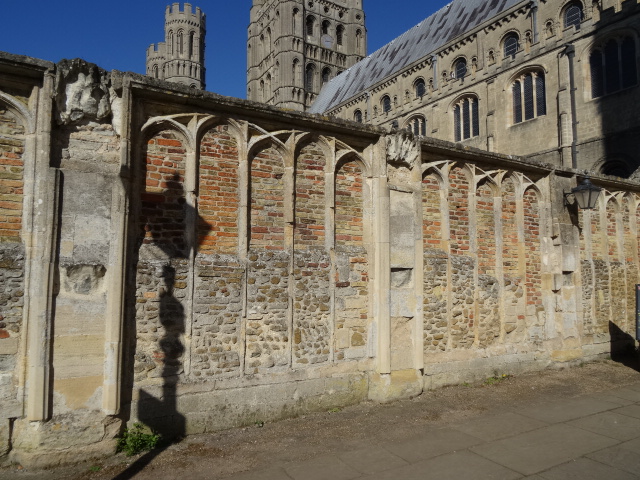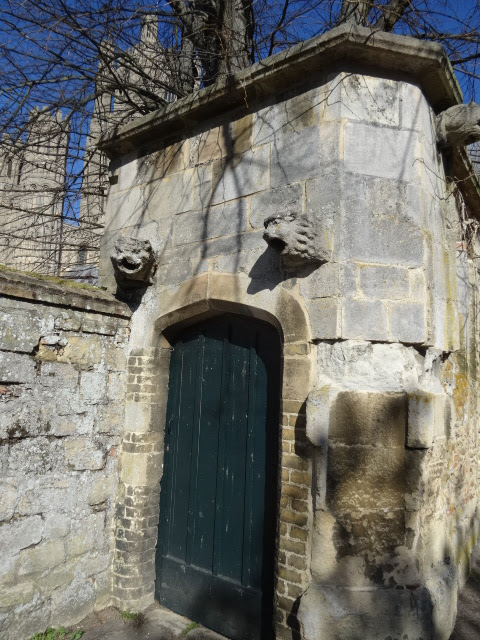Ely the stately
Shining a land mark
O'er the broad water
Gold-bright in the sunrise
Gold-red in the sunset
Grey in the waning
Kissed by the moonbeams
Glimmering through mist-cloud
Magic and matchless.
Magic and Matchless. Ely cathedral is unique and quite remarkable. It stands, vast and complex, in the midst one of England's smallest cities, on an 'island' in the East Anglian fenland. Not a landscape of immediate satisfaction, those level unending acres where the straight line predominates and 'where everything is three quarters sky' - a place that is easy to dislike. As I write this I am put in mind of these lines of Philip Larkin, though here he is writing about the level land of Holderness, and here in these flat Fens the land meets the North Sea not with a bang but a whimper.
And out beyond its mortgaged half-build edges
Fast-shadowed wheat-fields, running high as hedges,
Isolate villages where removed lives
Loneliness clarifies. Here silence stands
Like heat. Here leaves unnoticed thicken,
Hidden weeds flower, neglected waters quicken,
Luminously-peopled air ascends;
And past the poppies bluish neutral distance
Ends the land suddenly beyond a beach
Of shapes and shingles. Here is unfettered existence:
Facing the sun, untalkative, out of reach.
Ely, it has to be said, like the other Fenland towns tends like the landscape itself, to the utilitarian, being work-a-day sort of place. But beauty exists: Ely has it, as do King's Lynn, Boston, Wisbech and Spalding. Surprisingly perhaps. Still, the little streets climb the hill from the river, from the forgotten hithes, past the grey warehouse and the cottage or from the station, to the cathedral. And there it stands. Heroic in scale and intent. Built from oolitic limestone brought all the way from Barnack in the Soke of Peterborough some forty odd miles to the west. Almost like an act of foolishness. A place of holiness and ancient. The contrast could not be more marked.
I suppose I must now talk history. I won't bore you with too much of it. Just enough to give you an idea why the cathedral was constructed. As with the life of St Chad the life of St Etheldreda of Ely is all rather eventful, reading somewhat like a soap-opera or 19th century Sensation Novel. I seem to be waxing in my cynicism where this sort of thing is concerned.
All you need to know here is that c. AD 673, in her early 30s, Etheldreda, daughter of King Anna of East Anglia, founded a monastery (a double house for men and women) believed to be on the site of the present cathedral. She was (of course) abbess, and she remained so until her death some six or seven years later, c 679. She would have been about 45 years old. It could be that she was actually re-founding an earlier monastic foundation on the Isle, at a place called Cratendune, and was sacked (c650?) by the Mercian army under King Penda. Much of this detail comes from the much later 'Liber Eliensis'. Bede writing closer to the events is that bit more circumspect. Whatever happened, Etheldreda gained a reputation for holiness and Ely became a place of pilgrimage.
Researching these early saints can be confusing business and not even the cathedral authorities are immune from this: the cathedral website site suggests that Penda and his Mercian army were responsible for destroying Etheldreda's foundation, which would be quite the accomplishment for a man dead by at least some 18 years at the time of her own passing. It was the Viking raids that did for monastery. It was re-founded in 970 as a Benedictine house for men by King Edgar and St Ethelwold, bishop of Winchester, as part of a wider reform movement in the English church. (We've come across that old reprobate Ethelwold before at Peterborough and Thorney which were also his foundations.) It soon became staggeringly wealthy, the richest of all the fenland abbeys. In the 1109 it was raised to the rank of cathedral with the creation of the Diocese of Ely. In 1539 the priory was suppressed and after a wait of some 2 years (rather like at Peterborough) a new charter was granted in 1549. There followed the usual iconoclasm that accompanied the English Reformation. Up until the early 19th century the Isle and areas north, such as Wisbech, were a 'liberty' (at some point even a 'Palatinate'), with the Bishop of Ely exercising not only spiritual but temporal power. It was a practical solution to the often inaccessibility of the Isle due to flooding. There are however a couple of names that will reappear in these posts on the cathedral: Alan of Walsingham and James Bentham. Alan of Walsingham was a member of the monastic community, and he was a goldsmith. However, it is as architect or at least as patron that he is remembered. James Bentham (1709-1794) was a prebendary of the cathedral and an antiquarian and historian. He was the author of 'The History and antiquities of the Conventual & Cathedral Church of Ely: from the foundation of the monastery, A.D. 673, to the year 1771'.
So, to the precincts. The County History for Cambridgeshire considers them to be the largest in the country, amongst the Medieval cathedrals. I wonder if that is true? The precinct is bounded by (s) Back Hill, (w) The Gallery, (n) High St & Fore Hill and (e) Broad St. I'm not sure how many gates there were originally, but six are usually mentioned: the Ely Porta on the w, and four on the n along the High St: Steeple Gate medieval, timber-framed and Georgianised, which gave access to the now demolished parish church of The Holy Cross and the Lay Cemetery (now Holy Cross Green) on the N side of the cathedral. Beside the gate stood the demolished Chapel of St Peter, whose crypt served as a charnel house. Goldsmith's Tower, Sextry Gate (both associated with Alan of Walsingham) form along with Sextry and the Almonry a range on the s side of the High St.; then followed the lost Porta Monachorum. It was the largest of all the cathedral gates and opened out onto the Market Place. Finally, there was a gate on Broad St.
The cathedral and its ancillary buildings stand clustered together in the northwest corner of the precinct at the highest point of the site, a mere 68 ft above sea level. Most of the conventual buildings - cloisters, chapterhouse and dorter have gone, but to the s of the remains of cloister and the refectory is a complex of interrelated buildings: the King's Hall, the Queen's Hall, The West Range, and the Priors House. They have all been altered over time, but the collage of styles and materials, and elements of ruination is very satisfying. The Prior's House does retain the Priors Chapel, aka Prior Crauden's Chapel, one of the buildings associated with the time Alan of Walsingham. It is not usually open to the public, so I only have an image of the exterior to share with you. I searched on line for a suitable image of the sumptuous Decorated gothic interior but to no avail. (As of 04.04.25 I have found a 19th century book illustration that will suffice) There are no early paintings or prints available simply because sometime post-Reformation the interior was subdivided for domestic use. These intrusions were not removed until the middle of the 19th century, when the chapel was restored to sacred use under the supervision of Canon Stewart and Prof Willis. It is a building that really deserves a post all of its own.
To the se of the cathedral are the remains of the Infirmary. It reminds me of the similar infirmary at Peterborough (though much bigger) which was partly unroofed since the Reformation and houses built into the remaining fabric. I always thought that a similar process occurred here, but the story here may be more complicated as some unroofing occurred before the Reformation when at least two buildings were built onto the fabric; these included living accommodation for Alan of Walsingham and the 'Black Hostry' for Benedictine Monks to stay when travelling. Bentham, following William Stukeley, erroneously believed that the infirmary was the original conventual church. 'A Guide to the Cathedral Church and Conventual Buildings at Ely' 0f 1824 concurred stating: 'there is all certainty which the nature of the case admits, that the arches and columns we now behold, are the very same which were erected by the Virgin Queen our foundress in the year 673'. The Infirmary is actually Norman.
The rest of the precincts are given over to fields and a park which was laid out, I think, at the end of the 18th century. The Park contains the remains of a castle - a 4o ft high motte called Cherry Hill.
To the west of the cathedral is the triangular Palace Green. It is one the most attractive parts of the city with the former Bishop's Palace on the s and some attractive Georgian Houses on the n. 'The Cambridge Landscape', published in 1973, says that the Green represents the original settlement. the modern town centre is later Medieval development under the auspices of the Bishop of Ely. it was famous in the for the annual St Audrey fair, lasting 7 days around the feast day of St Etheldreda. It was the most important of the three fairs held in the city annually. It is the origin of the word 'tawdry'.













No comments:
Post a Comment